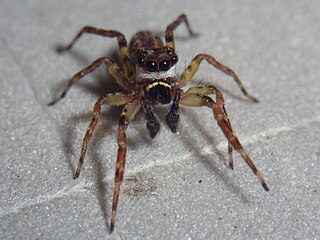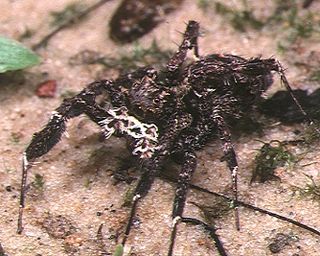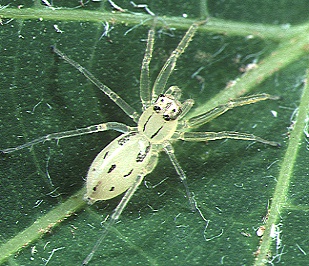
Jumping spiders are a group of spiders that constitute the family Salticidae. As of 2019, this family contained over 600 described genera and over 6,000 described species, making it the largest family of spiders at 13% of all species. Jumping spiders have some of the best vision among arthropods and use it in courtship, hunting, and navigation. Although they normally move unobtrusively and fairly slowly, most species are capable of very agile jumps, notably when hunting, but sometimes in response to sudden threats or crossing long gaps. Both their book lungs and tracheal system are well-developed, and they use both systems. Jumping spiders are generally recognized by their eye pattern. All jumping spiders have four pairs of eyes, with the anterior median pair being particularly large.

Lapsias is a spider genus of the jumping spider family, Salticidae.

The Spartaeinae are a subfamily of the spider family Salticidae. The subfamily was established by Fred R. Wanless in 1984 to include the groups Boetheae, Cocaleae, Lineae, Codeteae and Cyrbeae, which in turn were defined by Eugène Simon.
Galianora is a genus of Ecuadorian jumping spiders that was first described by Wayne Paul Maddison in 2006. As of June 2019 it contains only two species, found only in Ecuador: G. bryicola and G. sacha.
Galianora sacha is a species of jumping spider from Ecuador.
Galianora bryicola is a species of jumping spider from Ecuador.

Lyssomaninae is a subfamily of jumping spiders. It includes four genera, three from the New World.

Zygoballus sexpunctatus is a species of jumping spider which occurs in the southeastern United States where it can be found in a variety of grassy habitats. Adult spiders measure between 3 and 4.5 mm in length. The cephalothorax and abdomen are bronze to black in color, with reddish brown or yellowish legs. The male has distinctive enlarged chelicerae and front femora. Like many jumping spiders, Z. sexpunctatus males exhibit ritualized courtship and agonistic behavior.

Lapsias lorax is a species of lapsiine jumping spider from Ecuador.
Eburneana wandae is a species of jumping spider in the genus Eburneana that mimics ants. It was named by Tamás Szűts after the Polish arachnologist Wanda Wesołowska. The male of the species was first described in 2003, with the holotype found in the forests of central Africa. It is a relatively large spider, 8.2 millimetres (0.32 in) long, and is distinguished from the similar Eburneana scharffi by its different geography, being found in Cameroon rather than Tanzania, and the shape of the spider's front legs.

Menemerus nigli is a species of jumping spider in the genus Menemerus that originates in Asia. The male was identified in 2012 by Wanda Wesołowska and Mario Freudenschuss, and the female by Pir Asmat Ali, Wayne Maddison. Muhammad Zahid and Abida Buttin in 2018. The spider is medium-sized, typically 4.89 millimetres (0.193 in) in length, with a dark brown carapace and grey-brown abdomen that has a distinctive cream and white pattern created by small hairs. It was originally found in India, Pakistan and Thailand but was also found to have been introduced into Latin America, the first specimens being identified in Brazil in 2020. It seems to thrive amongst the sunlit stucco walls that are common in cities across the region. Menemerus nigli is used as an example of the ability of species that adapt to human habitation to expand their ecological niche and become global species.

Phintella lajuma is a species of jumping spider in the genus Phintella that lives in South Africa. It was first described in 2013 by Charles Haddad and Wanda Wesołowska, and given a name to reflect the fact that it was first found in the forests around Lajuma Mountain in Soutpansberg. Only the female has so far been described. The spider is medium-sized and lighter in colour than its relative Phintella lucida. It has a light brown carapace and yellow beige abdomen that has a pattern of linesand patches. The epigyne is distinctively large and has a plate at the rear.

Phintella lunda is a species of jumping spider in the genus Phintella that lives in Angola. It was first described in 2010 by Wanda Wesołowska, and given a name to reflect the fact that it was first found in Lunda Sul Province. The spider is medium-sized and a similar shape to others in the genus. It has a very dark brown carapace that has edge markings and a greyish-brown abdomen that has streaks on the top and sides, but the main distinguishing feature are the copulatory organs. The male has a distinctive straight side to its palpal bulb, while the female has am epigyne which has two pockets and copulatory openings in cups.
Bacelarella gibbosa is a species of jumping spider in the genus Bacelarella that is endemic to Nigeria. The spider has a distinctive shape to the carapace that gives the species its name, which can be translated hunchback. It was first described in 2012 by Wanda Wesołowska and Glavis Edwards. The spider is medium-sized with a cephalothorax that has a length between 3.1 and 3.8 mm and an abdomen that is between 2.6 and 3.4 mm long. The female is larger than the male. It is also generally lighter in colour, the male having a darker brown carapace, clypeus and legs. The species can be distinguished from others in the species by the male's round small palpal bulb and long thin embolus and the larger pocket in the female's epigyne.

Stenaelurillus mirabilis is a species of jumping spider in the genus Stenaelurillus that lives in Kenya and Tanzania. It was first described in 2000 by Wanda Wesołowska and Anthony Russell-Smith. The spider is medium-sized, with a dark brown carapace between 1.75 and 2.7 mm in length that has two white stripes across its length and a black abdomen between {1.9 and 2.8 mm long. The female abdomen has orange sides and a white marking of a single stripe interrupted by other marks. The male abdomen has a white cross shape formed of five spors. It is distinguished from other members of the genus by the male's long, thin palpal bulb and the female's epigyne with its short and slightly bent insemination ducts.

Asemoneinae is a subfamily of jumping spiders. It was created in 2015 by Wayne Maddison. Most species are found in Africa or Asia. The subfamily initially had five genera, but Hindumanes was later transferred to the subfamily Lyssomaninae.

Hisponinae is a subfamily of jumping spiders. The subfamily has six known extant genera and three extinct genera.
Bacelarella dracula is a species of jumping spider in the genus Bacelarella that lives in Ivory Coast and Nigeria. It was first described in 2001 by Tamás Szűts and Rudy Jocqué based on a holotype found near Appouasso. The spider is medium-sized with a plain dark brown carapace that has a length between 2.3 and 3.0 mm and a mottled abdomen that is between 2.3 and 2.8 mm long. The female is larger than the male. The male has a prominent tooth, which gives the species its name, recalling the fictional Count Dracula. The male also has a distinctive long prong that extends from the palpal bulb and a long embolus that curves so far that it nearly ends at its start. The female can be distinguished by its epigyne, and particularly the tight coil at the end of the copulatory openings.
Bacelarella pavida is a species of jumping spider in the genus Bacelarella that is endemic to Ivory Coast. It was first described in 2001 by Tamás Szűts and Rudy Jocqué based on a holotype found near Appouasso. The spider is medium-sized with a dark brown carapace that has a length between 3.7 and 4.0 mm and a mottled abdomen that is between 3 and 4.5 mm long. The carapace has a yellow spot and the abdomen has a pattern of white bands and spots. The male differs from other spiders in the genus in having a short embolus. The female can be distinguished by the large plate on the epigyne and large flaps on the chamber at the entrance to the short copulatory ducts.
Bacelarella iactans is a species of jumping spider in the genus Bacelarella that lives in Guinea and the Ivory Coast. It was first described in 2001 by Tamás Szűts and Rudy Jocqué based on a holotype found near Appouasso and is named after the Latin for showing off, after the iridescent colours of the legs. The spider is medium-sized with a dark brown carapace that has a length between 3.1 and 4.4 mm and a mottled abdomen that is between 3.2 and 4.8 mm long. The female is larger than the male. The male has a distinctive pattern of spots on the tegulum, which has two prongs, and a long embolus that curves so far that it loops around itself. The female can be distinguished by its epigyne, particularly the large triangular plate and the long coiled copulatory ducts.









